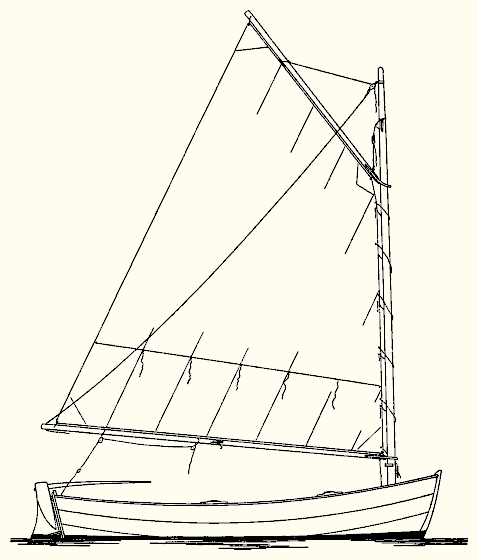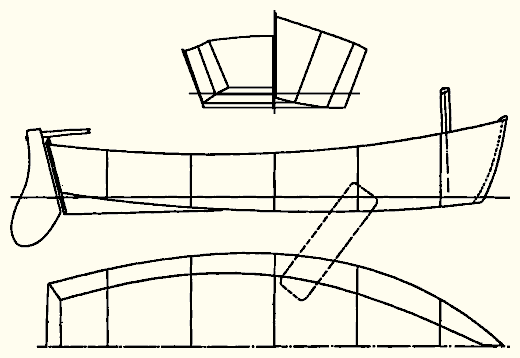

MARKED by simplicity and freighted with character the design this month shows a most practical and useful kind of little sailing boat. From her flat bottom to the tip of her unstayed mast. Tina, despite her modest dimensions, is very much of a little ship and, by the same token, very little of a toyish cockleshell. And, Shipmates, the latter is a matter which deserves serious consideration.
She is, therefore, an excellent craft in which to learn to sail; not only to sail, but to become, at least in some measure, a seaman or, in these modern days, a seawoman. She is a boat in which one may sail safely in rough windy weather, and not only safely but in a spirit of confidence and joy. An old Viking would enjoy her and the fishermen I used to know when sails were power, would love her. I think I know. When I was fourteen our neighbors at Atlantic Heights, N. J., were a family of fishermen � the Bergens. Lew was the youngest son, my age. Lew's boat was not unlike our latest child, Tina, a 10-foot long, flat-bottomed, cat-rigged skiff.

She seemed big to us; we were little. We sailed all over Sandy Hook Bay, off the point of the Hook greeting the red-stacked Cunarders, the black-and-white stacked American liners, the Frenchmen and the great German steamships as they carefully edged their way through the angular and shifting sands of the Sou'west Spit. We sailed around the U.S.S. monitor Passaic, guard ship during the Spanish-American war; even were aboard her. We sailed around the America's Cup challenger Shamrock I, along the beach in front of the officers' houses on Sandy Hook, to Spermacetti Cove, to the Navesink River, and were always tempted to try for a voyage through the Narrows. On windy days we sailed, rowed when there was no wind, and in the fog frightened ourselves by getting sometimes too close to the steamers, Monmouth, Sandy Hook or St. John, vessels that kept to schedule between New York and the steamboat dock at Atlantic Highlands. And what Nantucket sleigh-rides we had on the vigorous seas which followed in the wakes of those fast steamers!
Today little boys do not seem to go in for this kind of small boat sailing. Of compasses and sailing directions we knew nothing; of bailing scoops, reefing, rowing, and sailing we knew a lot. Lew did not know how to swim; I did, but little idea we had of doing anything except sticking to the little buoyant boat. However we always returned right side up to the beach, reasonably dry and in the best fisherman style. Is it any wonder I have always loved little boats? They were great fun in those long-ago yesterdays.

The design this month shows an able sort of flat-bottom catboat. In overall length she is 11 feet; in breadth, 4 feet 5 inches; in draft, slightly less than 5 inches. The free-board at the bow is 1 foot 11 inches, the least freeboard, 1 foot 1 1/8 inches, and at the stern, 1 foot 3 1/2 inches. She has pleasing flare, assuring dryness and reserve stability, a shipshape sheer line and a full deck line forward. The breadth of the bottom is wholesome without bluffness; the sweep of the bottom matches the general characteristics of the design as a whole.
Many boating folks think of a flat-bottom boat as a tub-like craft good only for boat liveries and rough work around docks. On the other hand there are many well designed and built flat bottom skiffs, inexpensive, easy to build and altogether excellent little, and sometimes big, boats of this simple model. The many sailing sharpies, for instance, the Thames barges, the astonishing craft of the Netherlands, the clamming and fishing skiffs of Long Island Sound, and the Great South Bay, to mention only a handful.

Our skiff Tina is not as small as she appears in the plans. She will carry two heavy persons and not be over-loaded, and three average-weight youngsters. The best of the little packet, aside from her handiness and usefulness, is the fact that she can be built by a first-class boatbuilder for a modest price, and the cost of her materials will not be frightening to an amateur builder. I cannot think of a boat so well suited to the training of junior members of a yacht club and one which at the same time can be used for racing and all-around pleasure sailing. Her rig is the rig of a little ship. Her handling will teach not only racing; but the essentials of seamanship, splicing, reefing, the care of sails left on the spars all summer, bailing, balance, rowing, landing on an unfriendly beach and all the elements that contribute to the knowledge of owning and handling a small sailing boat properly.
Tina, our latest cat-boat, is named to please a charming little girl who is the daughter of one of our neighbors, Mr. and Mrs. A. C. Johnson. Anchordown is close to Hindly School; kindergarten to sixth grade. During the 15 years we have lived here many boys and girls have stopped in on their way home from school; some to try their hands at typing, some to draw, some to make toy boats, and houses, some to while away childhood hours in the workshop which adjoins the office. Among those that first stopped in many are married and have babies of their own � so fast goes the time. From first to last the children have been well behaved, interesting, loyal and delightful little friends.